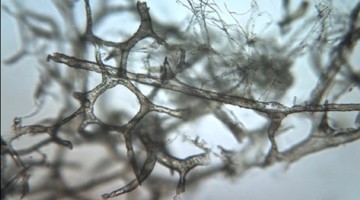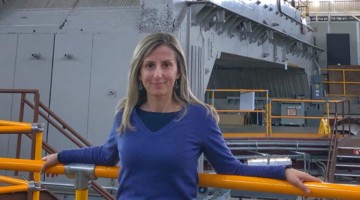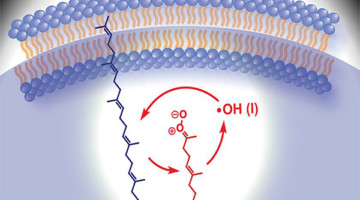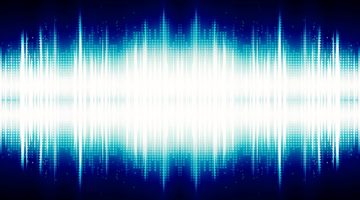An entirely new ring— the accumulator—is a key element of the ALS Upgrade (ALS-U) project. But what, exactly, does it do? How does swap-out injection differ from top-off injection, and how does it enable ALS-U? A short, 90-second explainer video provides clear answers to these and other questions. Read more »
Survival of T. rex Microvascular Structures from Deep Time
Researchers used several analytical techniques at the ALS to demonstrate how soft-tissue structures may be preserved in dinosaur bones, countering long-standing scientific dogma that protein-based body parts cannot survive more than one million years. Read more »
Stefania Trovati, Lead Radiation Physicist
As the lead radiation physicist at the ALS, Stefania Trovati is an expert in characterizing the radiation environment, but her expertise stretches beyond physics. She is also highly knowledgeable about raccoons and many other animals. Read more »
Criegee Intermediates Play Unexpected Role in Cell Chemistry
Researchers employed mass spectrometry to illuminate lipid nanodroplets under ultraviolet light. The results unexpectedly showed that hydroxyl radicals cause damage to cells via the formation of Criegee intermediates: molecules first proposed in 1975 to explain how pollutants react with the ozone layer in our atmosphere. Read more »
A Graphene Innovation That Is Music to Your Ears
A California-based company called GraphAudio is moving toward commercializing graphene-based audio technology developed by researchers at Berkeley Lab and UC Berkeley. The technology could transform a variety of devices, including speakers, earbuds and headphones, microphones, autonomous vehicle sensors, and ultrasonic and echolocation systems. Read more »
Alex Frano, Assistant Professor and UEC Chair
As a light source user, Alex Frano loves the camaraderie of beamtime, and he is excited to build on that sense of scientific collegiality as this year’s Users’ Executive Committee chair. You may have seen him on the experimental floor or at the User Meeting, but do you know his secret talent? Read more »
Can Minerals in the Earth’s Lower Mantle Store Water?
Earth is considered a watery planet, simply by virtue of the fact that 71% of its surface is covered by oceans. But researchers have discovered that, in the massive volume of material in Earth’s interior, minerals can serve as an important water reservoir, providing a new perspective on our planet’s water budget. Read more »
Probing the Evolution of Photovoltaic Films during the Spin-Coating Process
A new, in-beamline spin-coating platform enabled researchers to probe the structure of a promising photovoltaic material in the crucial early stages of processing. The results demonstrate the power of multimodal in situ techniques as promising tools for optimizing synthesis parameters and, thus, device performance. Read more »
Light Sources Form Data Solution Task Force
With funding from DOE for a two-year pilot program, scientists from the five light sources have formed a Data Solution Task Force that will demonstrate, build, and implement software, cyberinfrastructure, and algorithms that address universal needs between all five facilities. These needs range from real-time data analysis capabilities to data storage and archival resources. Read more »
Angela Setiadi, User Service Administrator, and Shawna Vila-Flores, Administrator
In Fall 2019, Angela Setiadi, user service administrator, and Shawna Vila-Flores, administrator, joined the User Office. Every user meets them—but do you know their nicknames for each other? Read more »
- « Previous Page
- 1
- …
- 22
- 23
- 24
- 25
- 26
- …
- 28
- Next Page »









